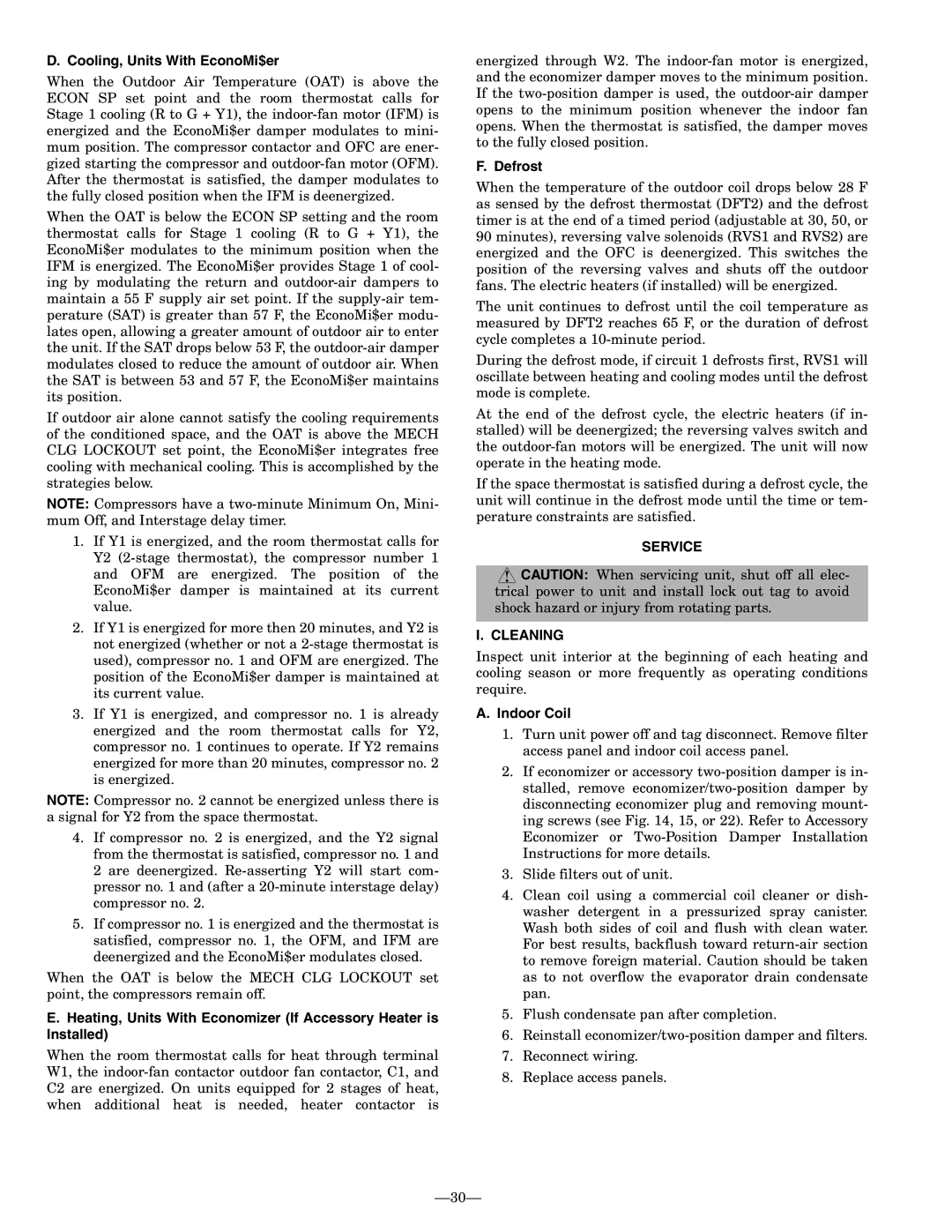D. Cooling, Units With EconoMi$er
When the Outdoor Air Temperature (OAT) is above the ECON SP set point and the room thermostat calls for Stage 1 cooling (R to G + Y1), the indoor-fan motor (IFM) is energized and the EconoMi$er damper modulates to mini- mum position. The compressor contactor and OFC are ener- gized starting the compressor and outdoor-fan motor (OFM). After the thermostat is satisfied, the damper modulates to the fully closed position when the IFM is deenergized.
When the OAT is below the ECON SP setting and the room thermostat calls for Stage 1 cooling (R to G + Y1), the EconoMi$er modulates to the minimum position when the IFM is energized. The EconoMi$er provides Stage 1 of cool- ing by modulating the return and outdoor-air dampers to maintain a 55 F supply air set point. If the supply-air tem- perature (SAT) is greater than 57 F, the EconoMi$er modu- lates open, allowing a greater amount of outdoor air to enter the unit. If the SAT drops below 53 F, the outdoor-air damper modulates closed to reduce the amount of outdoor air. When the SAT is between 53 and 57 F, the EconoMi$er maintains its position.
If outdoor air alone cannot satisfy the cooling requirements of the conditioned space, and the OAT is above the MECH CLG LOCKOUT set point, the EconoMi$er integrates free cooling with mechanical cooling. This is accomplished by the strategies below.
NOTE: Compressors have a two-minute Minimum On, Mini- mum Off, and Interstage delay timer.
1.If Y1 is energized, and the room thermostat calls for Y2 (2-stage thermostat), the compressor number 1 and OFM are energized. The position of the EconoMi$er damper is maintained at its current value.
2.If Y1 is energized for more then 20 minutes, and Y2 is not energized (whether or not a 2-stage thermostat is used), compressor no. 1 and OFM are energized. The position of the EconoMi$er damper is maintained at its current value.
3.If Y1 is energized, and compressor no. 1 is already energized and the room thermostat calls for Y2, compressor no. 1 continues to operate. If Y2 remains energized for more than 20 minutes, compressor no. 2 is energized.
NOTE: Compressor no. 2 cannot be energized unless there is a signal for Y2 from the space thermostat.
4.If compressor no. 2 is energized, and the Y2 signal from the thermostat is satisfied, compressor no. 1 and 2 are deenergized. Re-asserting Y2 will start com- pressor no. 1 and (after a 20-minute interstage delay) compressor no. 2.
5.If compressor no. 1 is energized and the thermostat is satisfied, compressor no. 1, the OFM, and IFM are deenergized and the EconoMi$er modulates closed.
When the OAT is below the MECH CLG LOCKOUT set point, the compressors remain off.
E.Heating, Units With Economizer (If Accessory Heater is Installed)
When the room thermostat calls for heat through terminal W1, the indoor-fan contactor outdoor fan contactor, C1, and C2 are energized. On units equipped for 2 stages of heat, when additional heat is needed, heater contactor is
energized through W2. The indoor-fan motor is energized, and the economizer damper moves to the minimum position. If the two-position damper is used, the outdoor-air damper opens to the minimum position whenever the indoor fan opens. When the thermostat is satisfied, the damper moves to the fully closed position.
F. Defrost
When the temperature of the outdoor coil drops below 28 F as sensed by the defrost thermostat (DFT2) and the defrost timer is at the end of a timed period (adjustable at 30, 50, or 90 minutes), reversing valve solenoids (RVS1 and RVS2) are energized and the OFC is deenergized. This switches the position of the reversing valves and shuts off the outdoor fans. The electric heaters (if installed) will be energized.
The unit continues to defrost until the coil temperature as measured by DFT2 reaches 65 F, or the duration of defrost cycle completes a 10-minute period.
During the defrost mode, if circuit 1 defrosts first, RVS1 will oscillate between heating and cooling modes until the defrost mode is complete.
At the end of the defrost cycle, the electric heaters (if in- stalled) will be deenergized; the reversing valves switch and the outdoor-fan motors will be energized. The unit will now operate in the heating mode.
If the space thermostat is satisfied during a defrost cycle, the unit will continue in the defrost mode until the time or tem- perature constraints are satisfied.
SERVICE
 CAUTION: When servicing unit, shut off all elec- trical power to unit and install lock out tag to avoid shock hazard or injury from rotating parts.
CAUTION: When servicing unit, shut off all elec- trical power to unit and install lock out tag to avoid shock hazard or injury from rotating parts.
I. CLEANING
Inspect unit interior at the beginning of each heating and cooling season or more frequently as operating conditions require.
A.Indoor Coil
1.Turn unit power off and tag disconnect. Remove filter access panel and indoor coil access panel.
2.If economizer or accessory two-position damper is in- stalled, remove economizer/two-position damper by disconnecting economizer plug and removing mount- ing screws (see Fig. 14, 15, or 22). Refer to Accessory Economizer or Two-Position Damper Installation Instructions for more details.
3.Slide filters out of unit.
4.Clean coil using a commercial coil cleaner or dish- washer detergent in a pressurized spray canister. Wash both sides of coil and flush with clean water. For best results, backflush toward return-air section to remove foreign material. Caution should be taken as to not overflow the evaporator drain condensate pan.
5.Flush condensate pan after completion.
6.Reinstall economizer/two-position damper and filters.
7.Reconnect wiring.
8.Replace access panels.
